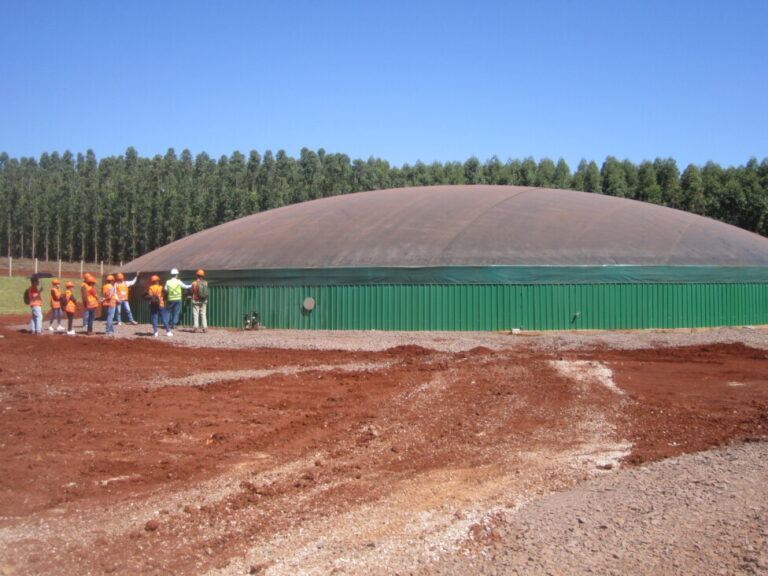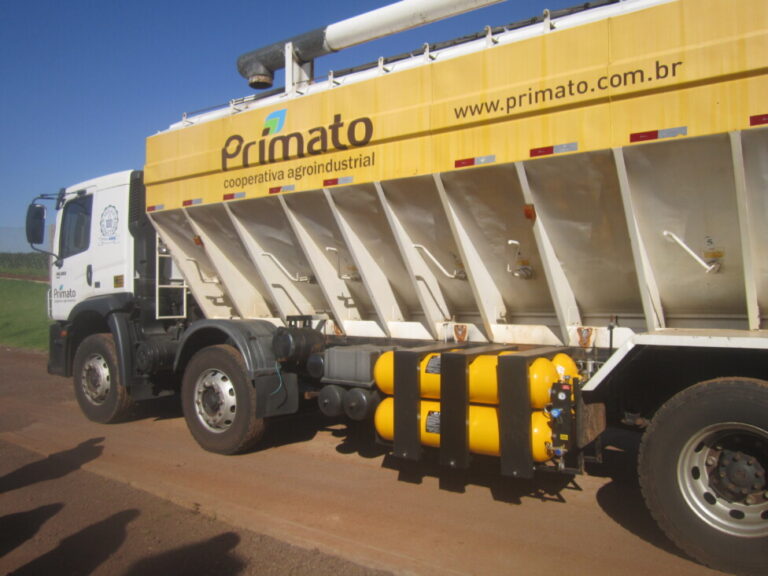
The Toledo Bioenergy Center, in southern Brazil, is under construction, but its biodigesters are already operating with manure and the carcasses of disease-free dead animals from 16 pig farms. The goal is to generate one megawatt of power and for pig farmers to participate in the production of biogas without having to invest in their own plants, so their waste is biodigested and turned into fertilizer, instead of polluting rivers and the soil. CREDIT: Mario Osava/IPS
By Mario Osava
TOLEDO, Brazil , May 8 2023 – It is the “best energy,” according to its producers, but biogas from livestock waste still lacks an organized market that would allow it to take off and realize its potential in Brazil, the world’s largest meat exporter.
“There is a lack of steady consumers,” said Cícero Bley Junior, who has been a pioneer in the promotion of biogas in the west of the southern state of Paraná, since he served as superintendent of Renewable Energies at Itaipu Binacional (2004-2016).
Itaipu, a gigantic hydroelectric plant shared by Brazil and Paraguay on the Paraná River which forms part of the border between the two countries, encourages nearby pig farmers to take advantage of manure to produce biogas, avoiding its disposal in the rivers that flow into the reservoir, whose contamination affects electricity generation in the long run.“The animal protein chain must also see itself as a generator of energy, just as the sugarcane sector defines itself as a sugar and energy industry since it began producing ethanol (a biogas) almost 50 years ago.” — Cícero Bley
The companies that form part of the animal protein chain, in general the meat industry that purchases animals ready for slaughter and offers breeding sows and technical assistance to livestock producers, should also buy biogas and its biomethane derivative from the breeders, Bley said.
“The animal protein chain must also see itself as a generator of energy, just as the sugarcane sector defines itself as a sugar and energy industry since it began producing ethanol (a biogas) almost 50 years ago,” he told IPS.
But the companies do not do so: none of them are affiliated with the Brazilian Biogas Association (Abiogás), he lamented. The dairy industry could greatly reduce the cost of picking up milk from farms if it replaced diesel with biomethane in its trucks, he said, to illustrate.
If no such decision is taken, there will be no large investments in gas-fired engines either, which can use natural gas or biomethane, also called renewable natural gas.
In addition to the environmental benefits, such as the reduction in water pollution and the decarbonization of energy, biogas offers economic advantages by making use of manure that was previously considered waste and converting it into biofertilizer.
It also drives a new equipment industry and local development by decentralizing energy and fertilizer production.
“It’s the best energy, for sure,” said Anelio Thomazzoni, a pig farmer from Vargeão, a small municipality of 3,500 inhabitants in the west of the state of Santa Catarina in southern Brazil. His farm has a 600-kilowatt biogas power plant and a 1-megawatt solar power plant.
“The correct use of crop waste, as fertilizer after biodigestion, made it possible for me to reduce by 100 percent the purchase of potassium chloride and phosphorus,” formerly essential fertilizers, he told IPS by phone from his town.

A visitor in Toledo examines the external controls of the mixer, an essential piece of equipment in the production of biogas and whose absence or mishandling can affect the operation. The complexity of biodigestion, compared to photovoltaic solar energy, is a factor that is slowing down the expected progress of biogas in Brazil, despite its multiple benefits in energy, environmental and economic terms. CREDIT: Mario Osava/IPS
Frustrated potential
Brazil today produces only 0.5 percent of the biogas that could result from agricultural, livestock and industrial waste, urban garbage and sewage, estimated Bley, who founded the International Center for Renewable Energies-Biogás (CIBiogás) in 2013.
Brazil would have the potential to replace 70 percent of the diesel it consumes if it allocated all the biogas to the production of biomethane, according to Abiogás. In terms of electricity, it could reach almost 40 percent, but today it is limited to 353 megawatts – around 0.0018 percent of the total – according to the government’s National Electric Power Agency.
In global terms, Brazil is only ninth in biogas electricity generation, accounting for 2.1 percent of the global total, according to the International Renewable Energy Agency (IRENA).
The sugarcane sector joined the effort five years ago in promoting biogas, with larger plants for power generation or biomethane refining in the southern state of São Paulo. New initiatives are attempting to accelerate the development of this energy market in the southern region of Brazil, which concentrates two-thirds of the national production of pork.
Residues from the production of sugar and ethanol from cane represent 48 percent of Brazil’s biogas potential, followed by the animal protein chain, which accounts for 32.2 percent, estimates Abiogás. The rest comes from agricultural waste and sewage.

This large pre-treatment tank uses pig carcasses, an abundant material that is still little employed in the production of biogas, which the Toledo Bioenergy Plant in southern Brazil will process to reach a generation capacity of one megawatt, playing a sanitary role at the same time. CREDIT: Mario Osava/IPS
Innovative initiatives
The Bioenergy Plant under construction by CIBiogás, a nonprofit technology and innovation institution in Toledo, a city of 156,000 people in western Paraná, seeks to “validate a possible business model,” explained Juliana Somer, a construction engineer who is operations manager at the Center.
Pig farmers provide the “substrate” and receive back a part of the “digestate”, as the manure converted into a better fertilizer is called, without the gases that make up the biogas, extracted in the biodigestion process. With that they fertilize their land.
To generate electricity, biogas must have at least 55 percent methane. Carbon dioxide (CO2) is another component, making up about 40 percent. Hydrogen sulfide must be removed to prevent corrosion of the equipment.
“The objectives are environmental, social, energy-related and the dissemination of technologies,” said Rafael Niclevicz, environmental engineer at CIBiogás. To that end, an area of high pig farm density was chosen, with about 120,000 hogs in five square kilometers.
The manure is collected daily, 70 percent by trucks and the pig farmers themselves, and the rest by pipelines from the nearest farms. Currently, 16 pig farmers, whose herds total about 40,000 animals, supply the plant, which also collects carcasses of disease-free dead pigs.
“The model makes sense for pig farmers who do not want to invest in facilities to produce biogas on their own. It solves the problem of waste disposal and there are socio-environmental benefits for everyone,” said Somer.

This Enerdimbo truck is powered by biomethane and is used to collect manure from 40 pig producers that feeds the company’s large biodigesters in southern Brazil. Solar power is added to biogas to provide 2.5 megawatts of energy, enough to supply 5,000 medium-sized households. CREDIT: Mario Osava/IPS
The plant is a joint project between the municipal government, which ceded the land, and Itaipu Binacional, which provided funding. The goal is an installed capacity of one megawatt.
In Ouro Verde, 22 kilometers from Toledo, a similar plant, Enerdinbo, receives the “substrate” from 40 farms within a radius of 15 kilometers, where more than 100,000 pigs are raised, for a total generation capacity of two megawatts, to which are added 500 kilowatts from a solar plant.
It is enough to provide electricity to 5,000 households, estimates EDB Energía do Brasil, the company that offers businesses and residential consumers the possibility of reducing their electricity bills by 10 percent by joining the cooperative that benefits from the electricity generated by Enerdinbo.
The business of EDB, created by businesspeople in Cascavel, 60 kilometers from Ouro Verde, is to implement small renewable energy plants to distribute the benefits of distributed generation among members of the cooperative, with the investment by the consumers themselves to save on energy costs.
Enerdinbo and the Toledo Bioenergy Plant seek to expand biogas by avoiding the difficulty for pig farmers and other small farmers or ranchers to invest in the energy business.

A view of one of the three large biodigesters of Enerdimbo, a plant of the EDB Energía do Brasil company that distributes the benefits of distributed electricity generation to numerous members of the cooperative, whose power bills are thus reduced by 10 percent. CREDIT: Mario Osava/IPS
Demand from animal protein producers
“Small and medium-sized rural producers are true heroes who face various risks when deciding, in isolation, to implement a waste treatment project generated in the animal protein chain for the production of biogas on their properties,” said a manifesto from the producers and bioenergy specialists.
The document, released at the South Brazilian Biogas and Biomethane Forum on Apr. 18 in Foz do Iguaçu, in the far west of Paraná, calls for greater support from the public sector and from companies that link biogas production and the meat industry, for their “strategic value for Brazil’s energy transition.”
Only 333 animal waste biogas plants are suppliers to the national electricity grid, that is, 0.005 percent of Brazil’s 6.5 million livestock farms, the document stressed.